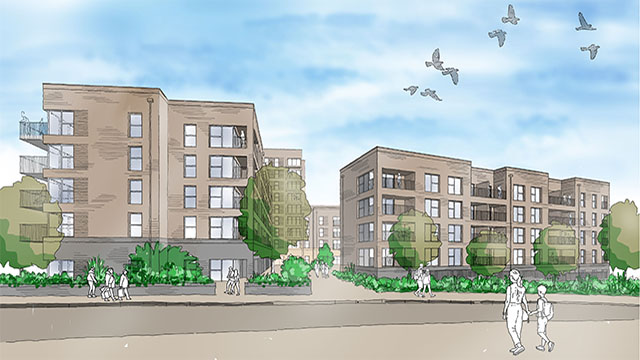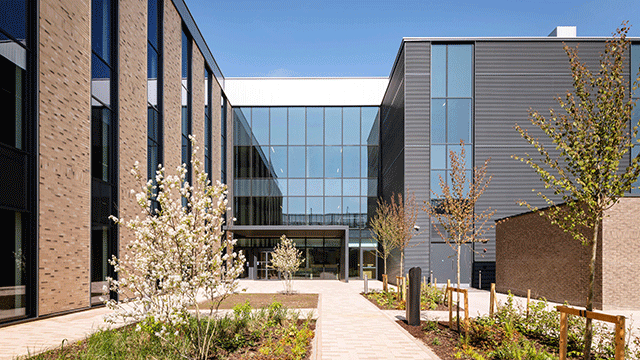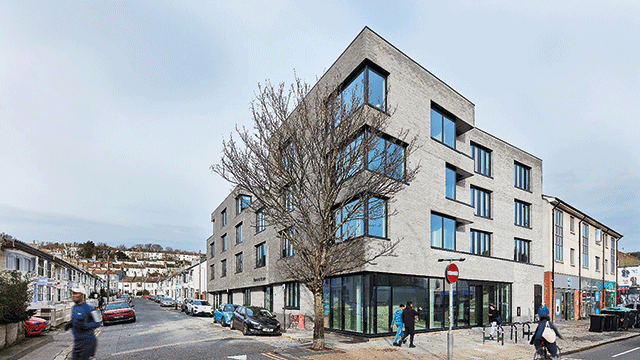The strength of Edinburgh’s office and residential markets is forcing industrial occupiers to the outskirts of the city, with smaller users being the worst affected. Helen Osborne reports
While Livingston is making news as the oasis of Edinburgh’s industrial market, traders in the city itself are fast deserting premises. It is especially hard for smaller users to find sites.
The in-town market is being particularly hard hit because of the high prices that the residential and office markets are prepared to pay.
Premises of more than 3,050m2 (10,000 sq ft) command the equivalent of £185,300 per ha (£75,000 per acre) for industrial use in Edinburgh, a feather in the wind compared with the £2.47m per ha (£1m per acre) that can be offered for residential. Consequently developers are no longer eager to invest in industry.
The city is losing smaller users, which are unable to find sites, to outlying locations such as Broxburn.
Some users are willing to move. But others are struggling, in particular trade-counter occupiers such as tile distributors and plumbers’ merchants. Operations that need access to the city and a prominent location are having to settle for out-of-town estates that lack the necessary visibility, according to David Fraser of King Sturge.
He witnesses many national outlets being forced to put their requirements on hold because they cannot find the right accommodation. Meanwhile, local operators are having to compromise, which Fraser believes must be affecting their trade.
The owner of machinery hire firm A-Plant says that it has been forced to leave its premises because the landlord wants to sell the property for residential use. Because most of the hire firm’s clients are businesses, location is not crucial.
However, A-Plant’s sole proprietor Alan Hertz says: “There is no question that the weight of residential values is pushing industry out of the city.”
On the other hand, some occupiers are leaving out of choice. Roy Durie at Ryden gives the example of a long-established printing company that it acted for, Waddie & Co, which sold its premises for a high residential value to fund a move to Livingston.
Customer contact at risk
Locating outside the centre may not necessarily be a problem for large operators, but for companies that have traditionally maintained a city presence, a 15-mile move out of town can mean a loss of business.
John Stevenson of Knight Frank receives many enquiries from smaller companies which, he says, are frustrated at no longer being in Edinburgh. He knows of two companies that would like to be in Sighthill but are unable to find space. And Stevenson points out that occupiers moving further afield face losing their existing staff.
He emphasises: “The provision of industrial accommodation needs to address demand for smaller units.” But Stevenson is doubtful that this will happen, saying that key locations have already been earmarked and it is now too late to change tack.
He blames a dearth of suitable sites. “Developers are aware that, if they could find a site, they could let it for up to £6 per sq ft,” he adds.
Stevenson feels that local authorities are not doing enough. “The council and Scottish Enterprise Edinburgh & Lothians could help to identify brownfield sites,” he says. “If there was a cohesive plan, it could be done.”
The council has also missed opportunities with locations such as Chesser Avenue, off Slateford Road to the south-west of the city, he believes. The multi-owned site could have been pulled together as a strategic site, he says, but is instead being developed in bits.
Norman Jamieson, the council’s research and information manager for economic development, agrees that the residential and office markets are much more valuable but feels it is difficult to counter market forces.
The council is concerned about losing companies, says Jamieson, but it is a difficult issue to address. He does not see Edinburgh as competing to attract industry, and comments: “There is little industry left to lose.”
The only planned allocation of land for industrial use is in The South East Wedge and Edinburgh waterfront. Each area will comprise 25ha (61.8 acres), but these are mixed developments.
The waterfront development will be the largest regeneration development project in East Scotland and will provide 45,000m2 (485,000 sq ft) for industrial use, compared with 50,000m2 (538,000 sq ft) of office space. Stevenson is disappointed that more industrial was not included in the scheme.
The council’s lack of intervention in designating specific industrial areas worries Derek Tyson of GVA Grimley: “It is not really that bothered. We’re in danger of becoming a one-horse race.”
He adds: “We shouldn’t have everyone working in a call centre.”
Tyson believes that, if someone was to develop a site near the A720 circling the city, for the smaller user, they would certainly see a good return for their investment.
Stevenson is pessimistic. He predicts: “In the next few years most traditional industry will disappear.” It is unwise to leave the city’s future hinging on the success of the financial sector, he warns.
|
New industrial accommodation supply in Edinburgh |
|||||
|
Many tenants looking for space will have to wait until schemes are constructed |
|||||
|
Address |
Developer/owner/agent |
Size (m2) |
|||
|
Phase two, Sir Harry Lauder Rd, A1 ind park |
Ryden/King Sturge |
1,858 |
|||
|
Phase three, Sir Harry Lauder Rd, A1 ind park |
Ryden/King Sturge – not yet built |
2,787 |
|||
|
West Shore Business Centre, Granton |
Edinburgh city council – not yet built |
2,000 |
|||
|
Premier 9, Newbridge |
PPG/Ryden – not yet built |
7,432 |
|||
|
Prestonfield Park, phase one |
Walker Group/J Smart & Co – not yet built |
14,028 |
|||
|
Salamander Street FM Developments |
Ryden |
1,765 |
|||
|
West Craigs Ind Est, Turnhouse Road West |
Craigs Properties/Ryden |
836 |
|||
|
Edinburgh Interchange, Newbridge |
Welbec/Ryden – not yet built |
20,438 |
|||
|
Source: Ryden |
|||||
|
New industrial accommodation outside Edinburgh |
|||||
|
Address |
Developer/owner/agent |
Size (m2) |
|||
|
Oakbank Park, Livingston |
Sheridan Estates/Ryden – not yet built |
5,574 |
|||
|
Oakbank Park, Livingston |
Scottish Life/West Lothian council |
2,550 |
|||
|
Rosebank Park, Livingston |
Scottish Life/West Lothian council |
4,305 |
|||
|
Starlaw South, Livingston |
West Lothian council/ McDonald Est |
2,601 |
|||
|
Starlaw Park, Livingston |
EIEL – not yet built |
2,787 |
|||
|
Dunlop Sq, Deans Ind Est, Livingston |
Thomas Mitchell Industrial/West Lothian council |
2,000 |
|||
|
Charlesfield Rd, Kirkton Campus, Livingston |
Scottish Life/West Lothian council |
1,672 |
|||
|
Carmondean, Livingston |
G Dunbar & Son/West Lothian council |
464 |
|||
|
Deans, Livingston |
G Dunbar & Son/West Lothian council |
464 |
|||
|
Whitehill Ind Est, Bathgate |
G Dunbar & Son/West Lothian council |
1,486 |
|||
|
Raehead, Linlithgow |
G Dunbar & Son/West Lothian council |
464 |
|||
|
Bilston Glen Ind Est, Loanhead |
IMEX Enterprise |
186 |
|||
|
As above |
J Smart & Co/King Sturge |
4,180 |
|||
|
Phase two, Dryden Vale, Bilston Glen, Loanhead |
DM Hall |
1,440 |
|||
|
Newhailes Ind Est, Musselburgh |
Rower Developments – not yet built |
557 |
|||
|
Hardengreen Ind Est, Dalkeith |
J Smart & Co/King Sturge |
2,100 |
|||
|
Source:Ryden |
|||||
|
Key facts |
||
|
Livingston is closing the gap on Edinburgh rents |
||
|
Prime locations Newbridge, Livingston, South Gyle and Sighthill, according to Jones Lang LaSalle. While Fife is a potential location for development, there is apparently a “psychological barrier” against this |
||
|
Average rents, according to Ryden: |
||
|
Edinburgh (South Gyle) |
||
|
1995 |
£22 per m2 |
|
|
1996 |
£22 per m2 |
|
|
1997 |
£24 per m2 |
|
|
1998 |
£24 per m2 |
|
|
1999 |
£26 per m2 |
|
|
2000 |
£26 per m2 |
|
|
2001 |
£28 per m2 – predicted |
|
|
Livingston |
||
|
1995 |
£18 per m2 |
|
|
1996 |
£19 per m2 |
|
|
1997 |
£19 per m2 |
|
|
1998 |
£19 per m2 |
|
|
1999 |
£21 per m2 |
|
|
2000 |
£21 per m2 |
|
|
2001 |
£27 per m2 – predicted |
|
Current trends
Future trends
|
||
|
Expanding horizons: Occupiers look for other labour pools |
|
As occupiers look outwards from Edinburgh, other markets are benefiting. The main beneficiary is Livingston, and Newbridge is also an emerging market. “Livingston is becoming a real focus to live and work,” says Chris Simpson of DTZ Debenham Tie Leung. However, Derek Tyson of GVA Grimley thinks that, while Livingston is close enough to the city, the land and labour supplies are limited there. And he points out that the area is more suited to large operators than small ones: “Livingston is on a larger scale. Smaller traders have never been its niche,” he says. He observes that the town’s labour supply is getting tight. According to Tyson, a lot of occupiers in the area that are expanding are now having to think about tapping into labour pools elsewhere. He says that companies are looking further east and very far west. So is Edinburgh ultimately in danger of losing its industry to Glasgow? Considering that the western rival has always had a bigger industrial market, Tyson says: “It must be a thought.” While there is still a lot of land in Livingston, he observes that it is quickly being used up, and fears that in five to 10 years the supply may have run out. While John Stevenson of Knight Frank sees West Lothian council’s approach to development as extremely proactive, he also thinks the area could lose occupiers. “Glasgow benefits from Hamilton International Technical Park and the Eurocentral area,” he says. “Being on such a strategic scale, only Livingston can compete.” While there is no evidence so far of occupiers making comparisons, Stevenson fears a westward flow. Despite efforts from Livingston to bring sites forward, typical sites pale against the scale of Eurocentral, for example. Ben Reed of Jones Lang LaSalle says: “There is demand for large-scale sites.” He refers to the Scottish industrial market using the term that is is fast being adopted: “Silicon Glen”. |










